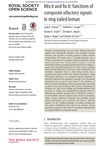Mix it and fix it
| dc.contributor.author | Greene, Lydia K. | en_US |
| dc.contributor.author | Grogan, Kathleen E. | en_US |
| dc.contributor.author | Smyth, Kendra N. | en_US |
| dc.date.accessioned | 2016-07-04T03:49:03Z | |
| dc.date.available | 2016-07-04T03:49:03Z | |
| dc.date.issued | 2016 | en_US |
| dc.identifier.other | HPU4160384 | en_US |
| dc.identifier.uri | https://lib.hpu.edu.vn/handle/123456789/21901 | en_US |
| dc.description.abstract | Animals communicating via scent often deposit composite signals that incorporate odorants from multiple sources however, the function of mixing chemical signals remains understudied. We tested both a ‘multiple-messages’ and a ‘fixative’ hypothesis of composite olfactory signalling, which, respectively, posit that mixing scents functions to increase information content or prolong signal longevity. | en_US |
| dc.format.extent | 10 p. | en_US |
| dc.format.mimetype | application/pdf | en_US |
| dc.language.iso | en | en_US |
| dc.subject | Biology | en_US |
| dc.subject | Behaviour | en_US |
| dc.subject | Ecology | en_US |
| dc.subject | Evolution | en_US |
| dc.subject | Olfactory communication | en_US |
| dc.subject | Scent mark | en_US |
| dc.subject | Composite signal | en_US |
| dc.subject | Strepsirrhine primate | en_US |
| dc.subject | Behavioural bioassay | en_US |
| dc.subject | Intrasexual competition | en_US |
| dc.title | Mix it and fix it | en_US |
| dc.type | Article | en_US |
| dc.size | 470KB | en_US |
| dc.department | Education | en_US |
Files in this item
This item appears in the following Collection(s)
-
Education [806]

